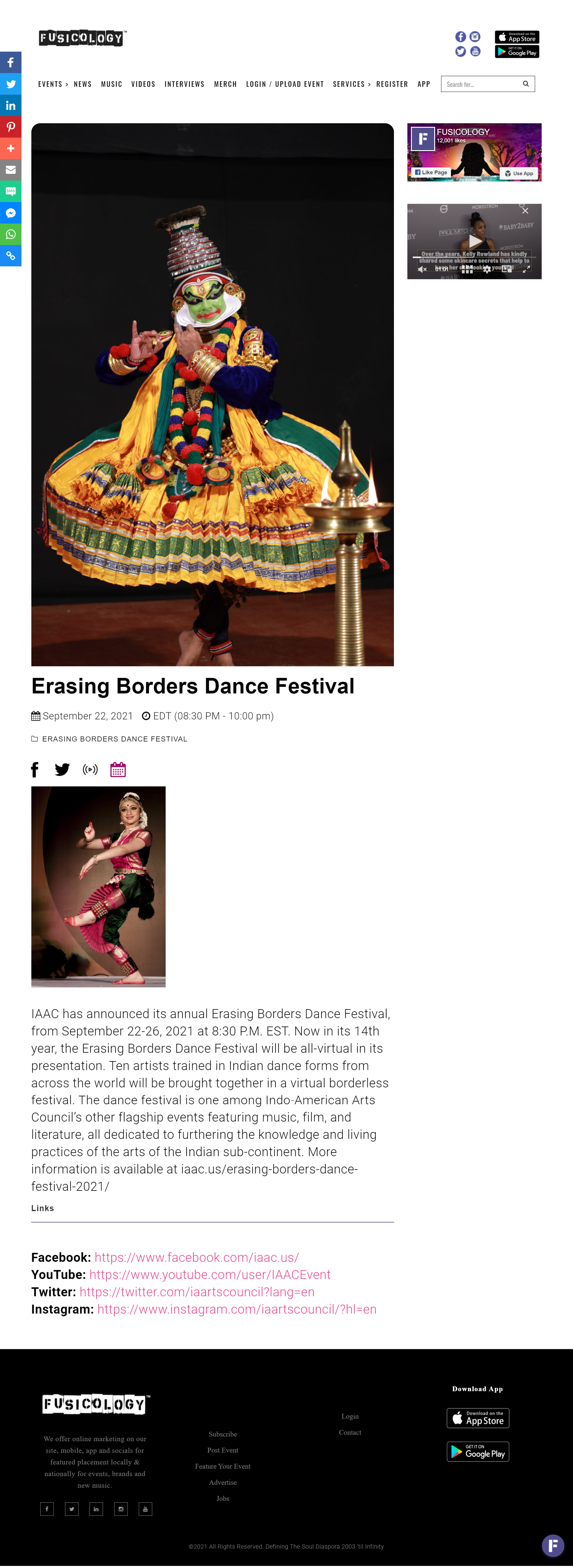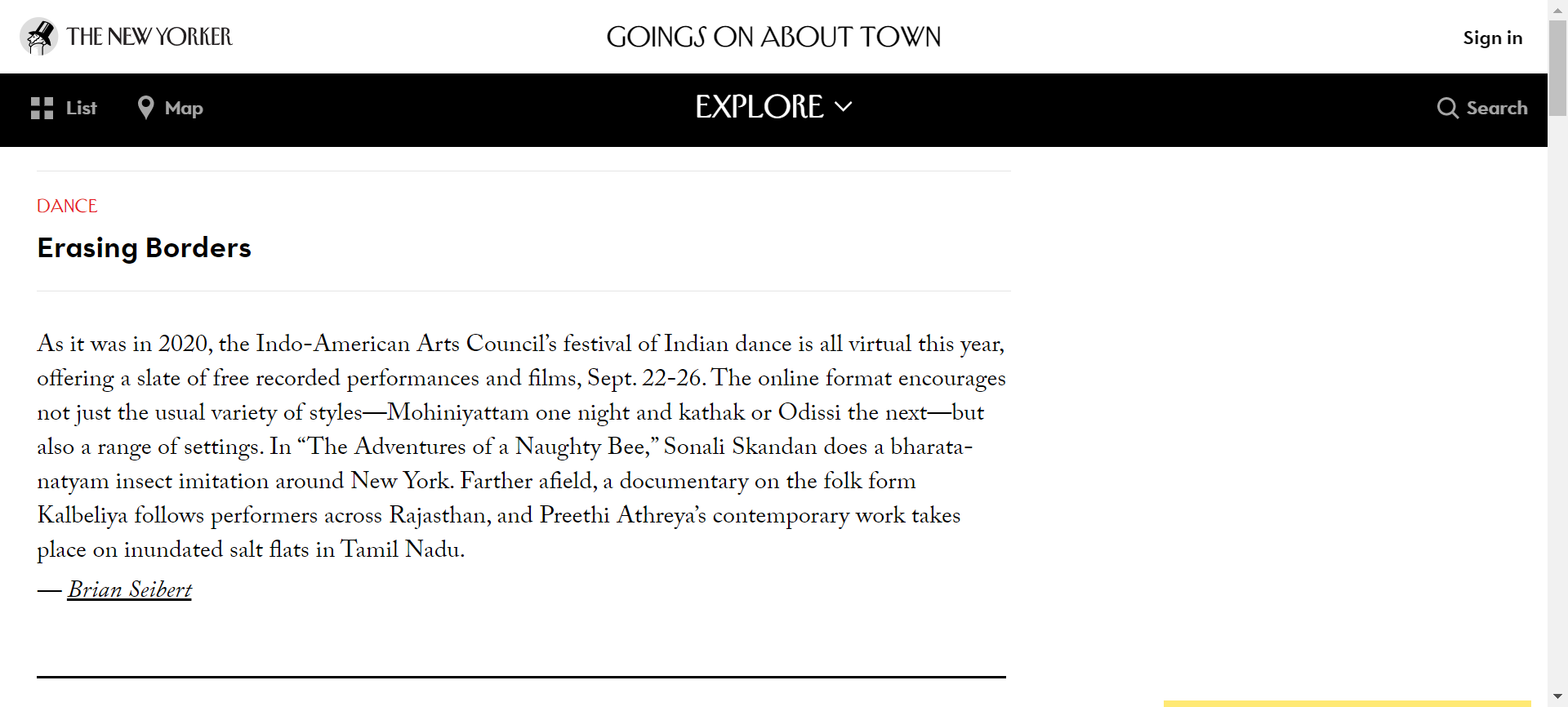ERASING BORDERS DANCE FESTIVAL
September 22-26, 2021 at 8:30 P.M. ET.
Please RSVP to get event reminders by email.
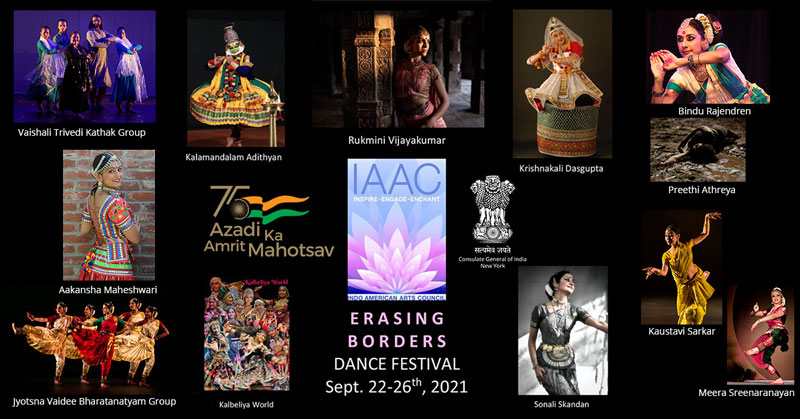
Schedule
Rukmini Vijaykumar in Bharatanatyam,
Preethi Athreya in Contemporary,
Sonali Skandan in Bharatanatyam
Rukmini, Preethi, Sonali in conversation with Kumudini Lakhia
Kalbeliya World Rajasthani folk,
Kalamandalam Adithyan Kathakali
Kalbeliya World and Kalamandalam Adithyan in conversation with Chitra Sundaram
Kaustavi Sarkar Odissi,
Jyotsna Vaidee Contemporary Bharatanatyam group
Kaustavi Sarkar and Jyotsna Vaidee in conversation with Sonal Mansingh
Vaishali Trivedi Kathak group,
Bindu Rajendren Mohiniyattam,
Meera Sreenaranayan Bharatanatyam
Vaishali Trivedi, Bindu Rajendren, and Meera Sreenarayanan in conversation with Arshiya Sethi
Morning workshop:
Dr Krishnakali Dasgupta Manipuri
Buy Ticket
Morning workshop:
Aakansha Maheshwari Rajasthani folk workshop.
Buy Ticket
Radio Partners

Media Partners



Curatorial Guidelines
We are only taking in digital applications this year.
You can submit solos, duets or larger groups.
Typically, artist/s performs for 7-12 min.
Your video is the most important part of your application. An impressive video can catch the eye of the curator and make your performance memorable. When submitting a video, make sure the video is well-lit and appropriately edited for maximum impact. Check out technical guidance. Below are some tips for editing your videos:
- The dancer should be clearly visible in the video.
- The video(s) you submit should be of the work that you propose to perform at the festival, and should submit a plan outlining exactly what you will plan to perform. In case the video exceeds the timing, please indicate time markers in your application for the segment/s you are proposing.
- You may submit up to 2 additional alternative videos with your application. Each video should follow ideally be less than 13 minutes.
- Dance works are often better appreciated when placed in context. We suggest that you include a commentary/explanation of process in the Details of the Proposed Work section of your application.
- Live explanations (i.e. spoken commentaries on your video) will be counted as part of the timing of the total presentation, so you may prefer to send in a written explanation.
- The video you submit should be include the complete, continuous work you intend to perform, OR a work-in-progress with detailed explanation if selected. It is imperative for the curators to see the entire work, because our decision making involves thinking through how all the selected works (by different artists) will collectively form a unique, cohesive experience for our audience. An excerpt put together with bits and pieces from different parts of a work or different works WILL NOT BE ACCEPTABLE for the application.
During 2021-22 across all IAAC platforms including dance, music, film, and literature, we are looking forward to celebrating the 75th anniversary of India's independence.
The 75th Independence anniversary celebrates and reflects on the milestones of freedom struggle, ideas at 75, achievements at 75, actions at 75, and resolve at 75.
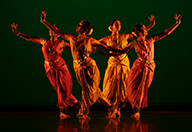
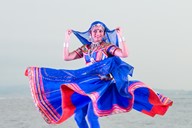
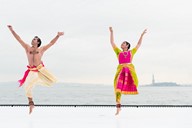

The dance festival will be virtual on IAAC’s streaming platform in late September 2021.
For this year, we are looking for dance works that speak to the above reflections. Pondering on the issues of old struggles, new ideas, hard won achievements, renewed actions, and future facing resolutions, how can we think of dance as our personal journey, our destination, and our sustenance? Do we dance to stimulate awareness? Do we dance in hope for a sustainable future? Do we dance proud of our heritage and part of the global world?
Your work need not answer all of the questions. Choose any one of these prompts as inspiration. We urge you to think of your own work and assess how it may answer this question. Please submit a 100-150 word description of how this question speaks to your own creative works.
We seek:
- Original works in multiple or new vocabularies and forms deriving from or relating to the traditions of Indian dance.
- Works that are challenging or critically thinking on their own terms.
- Given the online format we encourage shorter works this year. Professional works of up to 12 minutes duration (you can submit multiple works for us to consider).
Requirements:
- Completed Application Form, which will include a place for you to send us a link to the performance piece you want to showcase at the festival.
- Video: Applicants need to submit the entire video recording of the proposed works (not excerpts or sampling of past works). Since this is a virtual festival, we ask that you not apply with a work that is already published in video format with other platforms. This is a work that would be choreographed for camera, so we need to get a sense from your application as to how you would accomplish this.
- We plan on leaving the work accessible online for one week after the last day of the festival, so make sure you secure rights from your gurus, musicians, and collaborators. Please also make sure you own the rights to publish the music and other elements that you are using. This permission can be sent to you by other producers through emails, social media messages etc. so it can be documented if the need arises. If you submit work that we select, we assume you have done the due diligence.
- Only professional level performances will be considered for the festival. We plan on selecting between 7 and 12 artists this year depending on the pool of applications we receive. Typically we receive about 80 applications each year that our curators go through very carefully. Due to limited time, we do not email all applicants back, and prioritize writing to applicants we seriously consider for the festival.
- Selected artists will receive $250 for achieving a professional grade production value in addition to the performance fee.. Please submit a sample budget plan up to $250 for the final production to account for videography and editing.
- Non-refundable application fee of $15.
- Application Due date:March 31, 2021
Deadline extended to April 20, 2021
HOW TO SUBMIT:
We are only taking in digital applications this year.
- First, review the Curatorial Guidelines we have compiled. These guidelines will help you submit a strong application which catches the eye and interest of our professional curators.
- Selected artists are compensated with professional standard artistic fees for their work and time. Our fees are commensurate to other New York area professional companies.
- Additionally, if selected, we will provide funds towards video production costs for which technical guidance will be provided.
- Next, complete your application form. Bear in mind that you will not be able to save your application and come back to it later. So, it is recommended that you first draft your answers in a separate document, and then enter them on this online form in one sitting.
- Pay your $15 application fee through PayPal
 (using any credit card) Click here >>
(using any credit card) Click here >> - If you have any questions, check the Frequently Asked Question (FAQ). We keep updating this FAQ as new questions are received. If the FAQ does not address your questions, you can email us via this Inquiry form. Please note that we will only respond to questions that have not been addressed in the FAQ, so make sure to check the FAQ first!
- We have reduced the fees to $15.
Technical Suggestions
- Artist would film themselves at home/studio maintaining local COVID guidelines
- Make sure sound quality of the music is clear. It could be played on a different device close to the recording camera.
- have lighting from the front and avoid lighting at back (unless it is part of your aesthetic)
- Shoot in daytime conditions. Night time indoor shoots do not look good.
Artists Bios
Rukmini Vijaykumar in Bharatanatyam (Expectations and Yahi Madhava)
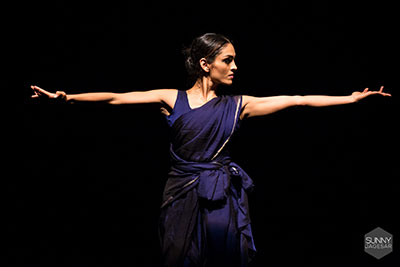
Rukmini Vijayakumar Is the Director of her Classical Dance Company Raadha Kalpa and her art space LshVa, in Bangalore, India. Rukmini began her formal training in dance at the age of eight. She had an initial exposure to ballet, but her primary training and rigorous practice through her early years was in Bharatanatyam.
She began under Guru Padmini Rao, and continued her practice under Guru Narmada, and Guru Sundari Santhanam (a senior disciple of Dr Padma Subrahmanyam). She was introduced to the teachings of the Natyashastra, and pursued an intense training in the Karanas under Guru Sundari Santhanam for many years.
She later was accepted into the Boston Conservatory, and graduated with a BFA in Modern dance and Ballet. She is an avid yoga practitioner and has studied Human Anatomy and Physiology at the Boston University. Rukmini's productions have toured the world and have been appreciated by audiences. Her ensemble work, Nayani and Prabhavati have toured the Middle East and USA, and more recently MALA, Unrequited, Talattu and The Dark Lord are productions within the traditions.
Preethi Athreya in Contemporary
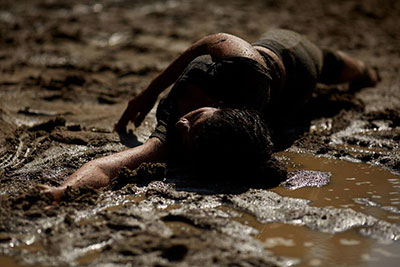 Photo by Binu
Photo by BinuA Chennai-based contemporary dancer, Preethi Athreya trained in Bharatanatyam and later went on to do a postgraduate degree in Dance Studies (Laban Centre, London, 2001). Keenly conscious of her need to be defined not as the exotic other, she chose to continue her journey in her native Chennai.
Between 1999 and 2011, she worked with Padmini Chettur from where she inherited the evolving legacy of Chandralekha and a strong commitment to constantly redefining the Indian body. Working within the Indian contemporary dance scene as a performer, choreographer and facilitator, Preethi belongs to a league of dance-makers in India today who use dance as an agent of change. Some of her well-known works are Conditions of Carriage: The Jumping Project (2015), The Lost Wax Project (2018), Light Doesn't Have Arms To Carry Us (2013) and BIRD (2021).
Preethi is one of the co-founders of Basement 21, a practice-based performance collective in Chennai. Her publications include a review of Total Masala Slammer by Belgian choreographer, Michel Laub/ Dance Research Journal, New York, 2014.
Sonali Skandan in Bharatanatyam in new work
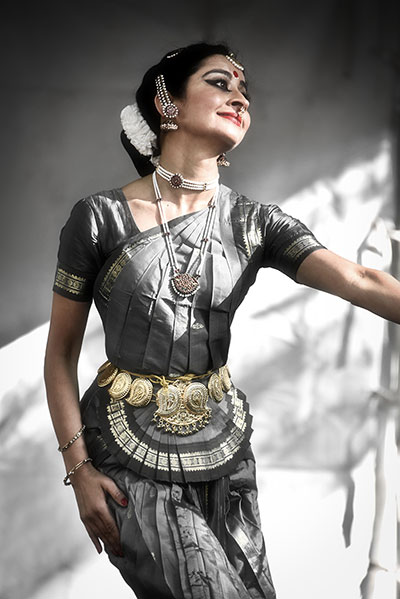
Sonali Skandan is a passionate dancer and choreographer whose work has been described as ‘natural yet tense with the pull of mystery’ (nytheatre.com). Sonali is the Artistic Director of Jiva Performing Arts, where she teaches and creates engaging dance productions, and Jiva Dance, a professional dance company presenting compelling works based on Bharatanatyam.
Sonali has received praise in the New York Times, Financial Times, and The NJ Star Ledger, among others. Sonali has been on the dance faculty at Sarah Lawrence College, Queens College and the Joffrey Ballet Summer Intensive.
Under Sonali’s leadership, Jiva Dance was also the first Indian Classical dance company to be awarded the CUNY Dance Initiative residency and awarded the inaugural Dance/NYC Dance Advancement Fund. Sonali has received support from the NEA, NY State Council on the Arts and The NYC Dept. of Cultural Affairs. Sonali is featured in Juilliard’s online course for Bharatanatyam. She is a longtime student of the legendary C.V. Chandrasekhar and Bragha Bessell and is receiving creative mentorship with celebrated dancer and choreographer Maya Kulkarni with whom she is exploring and creating rare poetic works.
Kalbeliya World Rajasthani folk-new documentary
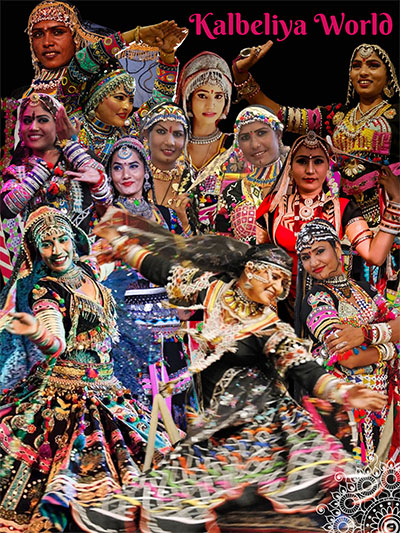
Kalbeliya World is an international solidarity program that safeguards the art forms of women from traditional families of the Kalbeliya community in Rajasthan. Kalbeliya World seeks to provide (1) Digital Literacy (2) Self Employment (3) Stable incomes for female dancers in the regions of Jaipur, Pushkar and Jodhpur.
During this digital performance, we will take you along a journey to the homes of those women, who are the bearers of their arts looking for sustainable alternatives to the future. This performance consists of 12 female artists from Rajasthan: Aasha, a dancer and a recording artist who released many Rajasthani tracks during the pandemic. Anita has toured in Europe several times and has an International student following. Gulabo brought Kalbeliya dance to the stage in 1981. She was awarded the Padma Shri. Khatu was the lead dancer for many performance troupes, including Musafir.
Mamta was performing in the Desert Camp Hotels full time before lockdown and had an International student following. Meena was the lead dancer for many performance troupes, such as Dhoad Gypsies. Moru is best known for her dance troupe who perform at great stages of Rajasthan and abroad. Morya makes exquisite jewelry and crafts when she is not performing or teaching. Raki has toured in Europe several times. She is well known on the performance stages in Pushkar. Rekha was performing in the Desert Camp Hotels full time before lockdown. Sunita regularly taught and toured in France
Kalamandalam Adithyan Kathakali
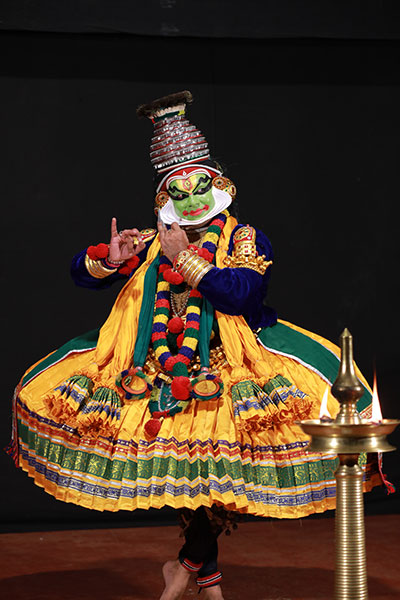
Rugmangada Charithram. This piece reveals the episode of Rugmangada meeting Mohini and what ensues. As a very captivating story, it is much loved by most kathakali audience. Adithyan performs Rugmangada in pacha- green makeup accompanied by Mohini stree veshsam-female costume bringing to viewers two very unique Kathakali veshams-looks on screen.
They are accompanied by 2 singers, 1 Chenda artist (drum), 1 Madalam (drum), 1 Chuttikaran ( make up artist), 1 Uduthukettukaran ( person who drapes the heavy costuming on the dancers).
Kalamandalam Adityan is a young artist in Kathakali. He hails from Kannur district in Kerala, South India. From the childhood days he had strong interests towards Kathakali. Payyannur TM Premnath is his first Guru. After completing his primary education, he joined Kerala Kalamandalam to study Kathakali from the eighth standard. Kerala Kalamandalam deemed university is an art institute, which offers academic studies along with Kathakali studies. With the guidance and discipline of gurus such as Kalamandalam Mukundan, Kalamandalam Harinarayanan, Kalamandalam Venkataraman, Kalamandalam Suryanarayanan, Kalamandalam Ramdas and Kalamandalam Krishnakumar, he completed his studies from 8th standard to degree. The stage entry was completed in 2009 by portraying the role of Krishnan in Purappadu. He continued onto a Masters program at Kerala Kalamandalam. During his masters, he received extensive opportunities to learn the art from renowned gurus such as Padmashree Kalamandalam Gopi ( Gopiyasan) and Kalamandalam MPS Namboothiri.
Kaustavi Sarkar Odissi, new work
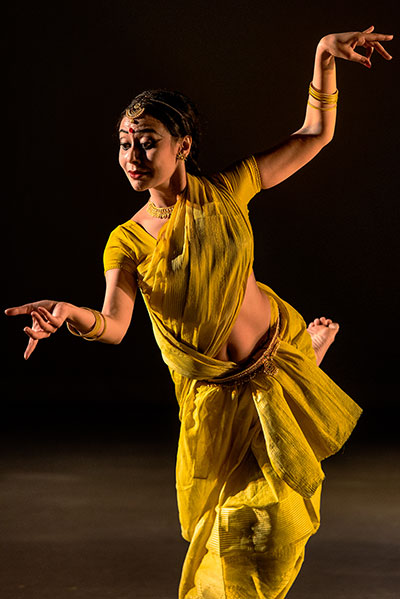
Dr. Kaustavi Sarkar, student of Guru Poushali Mukherjee, Ratikant Mohapatra, and Sujata Mohapatra, is a professor in dance at UNC Charlotte and runs a professional development opportunity for Indian classical dance educators through the continuing education program.
She received the prestigious National Endowment for the Arts grant for bringing Odissi into mainstream arts contexts. A Doordarshan graded, ICCR empaneled, and national scholarship holder, Sarkar has created a substantial body of work in scholarship, performance, and education.
She teaches inside and outside academia and maintains dual careers in performance and teaching. She has taught at Kenyon College and holds a PhD from The Ohio State University (OSU) with interdisciplinary research interests in digital humanities, cultural studies, queer studies, arts entrepreneurship, dance and community, and religious studies. Her monograph Dance Technology Social Justice focuses on Odissi's journey as a technique for social justice. Her second book Shaping S-Curves focuses on female choreographers in the field of Odissi.
Jyotsna Vaidee Contemporary Bharatanatyam group work on STORM, new work
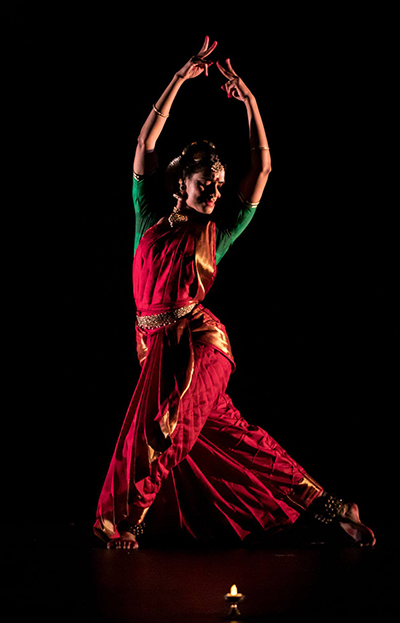 Raki Shekar photography
Raki Shekar photographyJyotsna Vaidee is an award winning Bharatanatyam choreographer and dancer and the founder of Samudra Dance Creations. Samudra has presented at several prestigious festivals including San Francisco International Arts Festival, the PushDance Fest and the Ragamala Music Society of Canada. Jyotsna advocates that the authentic technique of Bharatanatyam is a rich language that can be used to communicate and discover themes that are both traditional and contemporary. To that end, Jyotsna has created a number of full length original choreographic productions including The Quest Unsaid, The Caged Birds Sings and Kaavyam, and most recently, The Earth Speaks, which was nominated for an Isadora Duncan Dance Award in 2020. In addition to her choreographic work, Jyotsna is a well-established Bharatanatyam soloist who has immersed herself in the art for over 25 years. Her performances have received critical acclaim in India and North America. She is a regular performer at India's (Chennai) December dance and music season.
Jyotsna has always sought out rigorous training to perfect her art and is a long time disciple of renowned Gurus Padma Bhushan Prof. C.V Chandrasekhar and abhinaya exponent Smt. Bragha Bessell.
Vaishali Trivedi Kathak group, new work
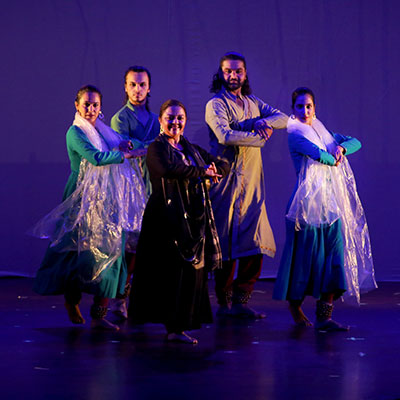 Vaidehi Patel photography
Vaidehi Patel photographyVaishali Trivedi is a Kathak dancer, choreographer and singer based in Ahmedabad. For the past 32 years she has performed in many important festivals and theatres, across India and more than 50 countries around the world. Acclaimed as rare dancer with melodious voice by artists and connoisseurs, Vaishali combines a perfect technique with flowing grace and a very fine sensitivity.
She also had the privilege of performing in the productions of some of the greatest Indian classical artists of our time: her Guru Smt. Kumudini Lakhia, Pt. Ravi Shankar, Pt. Birju Maharaj. She has collaborated with famous choreographers from France, Italy, Brazil, Germany, USA, Switzerland and Pakistan. Such experiences make her artistic journey a truly unique one.
In 2015 she was awarded the Fulbright Fellowship and was given ‘Gaurav Pursakar' by the Govt. of Gujarat in 2011. Today, Vaishali shares her time between touring, expanding her choreographic work in Kathak style, collaborating with various artists, singing and teaching at her institute, Sangati Centre for Performing Arts, Ahmedabad.
Bindu Rajendren Mohiniyattam, new work
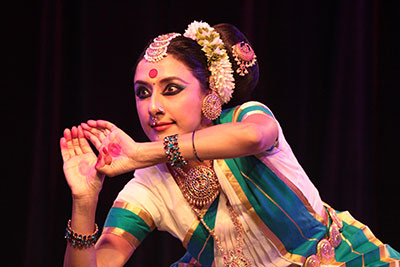
Eloquent facial expressions with graceful and flowing movements that evoke aesthetic experience are characteristics of Bindu Rajendren's Mohiniattam performances. As a performing artiste, Bindu's strength is in art of expression and storytelling abilities.
Central to Bindu's dance practices is the elemental spiritual connection through sentiment a and devotion. Bindu Rajendren is a practitioner of Mohiniattam, based out of Brisbane in Australia. She has performed at international, local and diasporic festivals and concerts in Australia, United Kingdom, New Zealand, UAE and India. She has widely collaborated with dancers, theatre artists, spoken word and visual artists and musicians.
The covid induced pandemic provided Bindu an opportunity to extend her movement vocabulary to include digital media with great success. As a dance researcher, Bindu has presented papers at various national and international academic dance conferences. An obsession with letting her mind wander is often what inspires Bindu's dance choreographies, artwork, paintings and poetry.
Meera Sreenaranayan Bharatanatyam
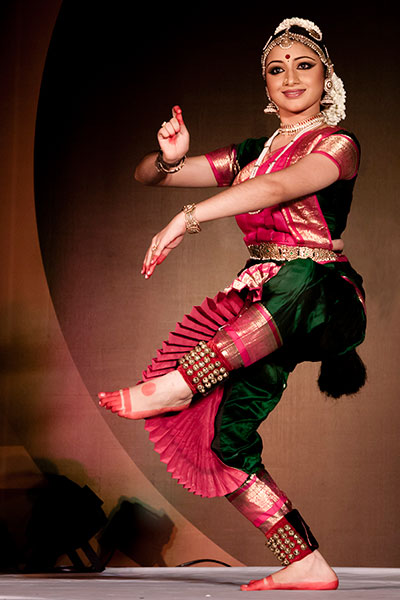 HareeshNamboothiri
HareeshNamboothiri'A performer totally without a consciousness of self or any feelings of wanting to be pretty. She was the dance,' the renowned critic Leela Venkataraman writes about Meera Sreenarayanan, a dynamic young aspiring artiste, from Guruvayur (Kerala, India).
She has been described as a 'sensitive dancer', praised for her subtle expressions and technical excellence which all together completes a narthaki. Meera was under the tutelage of Sri. Prakash, Sri. R.L.V. Anand and Acharya Kalakshetra Nirmala Nagaraj. Now Meera is exploring the art and abhinaya under the able mentorship of Acharya Indira Kadambi.
Many performances and awards are there to her credit. She is a graded artist in Doordarshan and also a recipient of CCRT Young Talent and NCERT Creative Talent scholarships. She was chosen as the best junior dancer at The Music Academy Madras Dance Festival 2019. 'Harini', a well-received and appreciated thematic Bharatanatyam solo creation, conceptualized and choreographed by Meera for Natyarangam of Narada Gana Sabha, Chennai, proves her caliber as a choreographer as well.
Dr. Krishnakali Dasgupta Manipuri
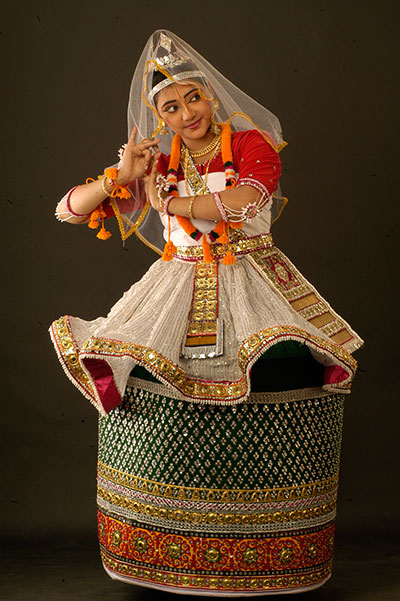 Sanat Ghosh
Sanat GhoshDr. Krishnakali Dasgupta a recipient of the prestigious Govt. of India National Scholarship for Outstanding artistes for Manipuri (Senior) is a senior student of the Manipuri exponents Smt.
Poushali Chatterjee, Dr. Sohini Ray, Guru Smt. Kalavati Devi and Guru Smt. Darshana Jhaveri, as well as Ojha Ranjeet Chingtham (Thang-Ta). She remains a dedicated performer and explorer of the form for more than 25 years and is a co-director, performer, choreographer with Mitradheya. Krishnakali is a Postdoctoral researcher in the field of Developmental Genetics. Dr Dasgupta has conducted several Manipuri workshops across countries.
Aakansha Maheshwari Rajasthani Folk Choreography workshop

Born and raised in Delhi, Aakansha spent over a decade training in Bharatanatyam under Padmashree Geeta Chandran and toured around India. She also performed with Nectar Dance Company and Shakti Dance Company Productions directed by the renowned Guru Viji Prakash’s and her daughter Mythili Prakash in California.
Aakansha has trained in Indian folk dance styles such as Garba, Kalbeliya, Ghoomar and Bhangra with various Delhi and Rajasthan based teachers who are specialists in their field. She spends around 2 months in India every year - dancing in Rajasthan and serving at Manav Sadhna NGO at Gandhi Ashram, working with hundreds of underprivileged kids. Aakansha acted and danced in the Hollywood movie Vara: A Blessing (2013) directed by Rinpoche Khyentse Norbu, shot in Sri Lanka after which she moved to LA. She is one of the co-founders of Kalbeliya World- an online platform with 12 Kalbeliya teachers and she has been volunteering for over a year in helping the community thrive during Covid crisis through the sustainable teaching model and also fundraising.
Rukmini Vijaykumar in Bharatanatyam (Expectations and Yahi Madhava)
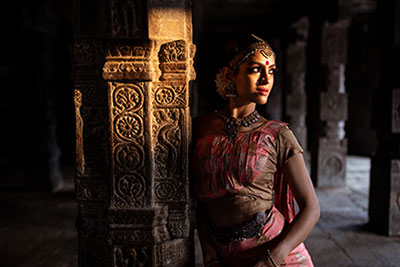
Rukmini Vijayakumar Is the Director of her Classical Dance Company Raadha Kalpa and her art space LshVa, in Bangalore, India. Rukmini began her formal training in dance at the age of eight. She had an initial exposure to ballet, but her primary training and rigorous practice through her early years was in Bharatanatyam.
She began under Guru Padmini Rao, and continued her practice under Guru Narmada, and Guru Sundari Santhanam (a senior disciple of Dr Padma Subrahmanyam). She was introduced to the teachings of the Natyashastra, and pursued an intense training in the Karanas under Guru Sundari Santhanam for many years.
She later was accepted into the Boston Conservatory, and graduated with a BFA in Modern dance and Ballet. She is an avid yoga practitioner and has studied Human Anatomy and Physiology at the Boston University. Rukmini's productions have toured the world and have been appreciated by audiences. Her ensemble work, Nayani and Prabhavati have toured the Middle East and USA, and more recently MALA, Unrequited, Talattu and The Dark Lord are productions within the traditions.
Credits: Choreography, Concept & Performance: Rukmini Vijayakumar
Music: Mixing & Mastering: Ambi Subramaniam
Violin: Ambi Subramaniam
Harpischord: Tiffany Vong
Video & Editing: Vivian Ambrose
Yahi Madhava is an Ashtapadi, (love poems of Radha and Krishna), from the Gitagovinda of Jayadeva. Radha finds that Krishna is not next to her when she awakes and realises that this means that he has been out all night. Krishna returns, his eyes red, disheveled, eyelids heavy from a sleepless night, and Radha instantly knows he has been with someone else. She says that it seems as though a new love has sprung in his heart, and tells him to leave. "Go be with her", says Radha. "The one with the beautiful eyes! She will assuage all your pain." She is so broken from his deceit that she asks him to leave even though she loves him with all her heart. Radha and Krishna represent the Purusha, and Paramatma, and the idea that one cannot posses the universal truth as it belongs to everyone. One can only recognise its presence in everything by surrendering to it.
Yahi Madhava
Raga: Ragamalika
Tala: Adi Tala
Composer: Jayadeva
Language: Sanskrit
Choreographed and performed by: Rukmini Vijayakumar
VIDEO CREDITS
Vivian Ambrose
MUSIC CREDITS
Vocals: Balasubramanya Sharma
Copyright: Raadha Kalpa Dance Company
Preethi Athreya in contemporary new work
 Photo by Binu
Photo by BinuA Chennai-based contemporary dancer, Preethi Athreya trained in Bharatanatyam and later went on to do a postgraduate degree in Dance Studies (Laban Centre, London, 2001). Keenly conscious of her need to be defined not as the exotic other, she chose to continue her journey in her native Chennai.
Between 1999 and 2011, she worked with Padmini Chettur from where she inherited the evolving legacy of Chandralekha and a strong commitment to constantly redefining the Indian body. Working within the Indian contemporary dance scene as a performer, choreographer and facilitator, Preethi belongs to a league of dance-makers in India today who use dance as an agent of change. Some of her well-known works are Conditions of Carriage: The Jumping Project (2015), The Lost Wax Project (2018), Light Doesn't Have Arms To Carry Us (2013) and BIRD (2021).
Preethi is one of the co-founders of Basement 21, a practice-based performance collective in Chennai. Her publications include a review of Total Masala Slammer by Belgian choreographer, Michel Laub/ Dance Research Journal, New York, 2014.
Performer/choreographer, Preethi Athreya and film-maker Vijay Boothalingam come together for an exploration of the salt pans at Marakkanam, Tamil nadu, to reflect upon the materiality of the site and its imprint on the body. The first of a three-part series, this particular project is a response to the terrain in the fallow period when salt production is suspended due to unseasonal rain and as such, it navigates a submerged terrain over salt deposits within clayiy soil.The body is placed at the meeting of earth, water and salt to challenge its own power and stability and to perhaps think of what we may consider to be eternal or transient .
Sonali Skandan Bharatanatyam in new work

Sonali Skandan is a passionate dancer and choreographer whose work has been described as ‘natural yet tense with the pull of mystery’ (nytheatre.com). Sonali is the Artistic Director of Jiva Performing Arts, where she teaches and creates engaging dance productions, and Jiva Dance, a professional dance company presenting compelling works based on Bharatanatyam.
Sonali has received praise in the New York Times, Financial Times, and The NJ Star Ledger, among others. Sonali has been on the dance faculty at Sarah Lawrence College, Queens College and the Joffrey Ballet Summer Intensive.
Under Sonali’s leadership, Jiva Dance was also the first Indian Classical dance company to be awarded the CUNY Dance Initiative residency and awarded the inaugural Dance/NYC Dance Advancement Fund. Sonali has received support from the NEA, NY State Council on the Arts and The NYC Dept. of Cultural Affairs. Sonali is featured in Juilliard’s online course for Bharatanatyam. She is a longtime student of the legendary C.V. Chandrasekhar and Bragha Bessell and is receiving creative mentorship with celebrated dancer and choreographer Maya Kulkarni with whom she is exploring and creating rare poetic works.
Adventures of the Naughty Bee
This is the story of a bee living in a hive hanging on the pillar of the magnificent Temple of Chidambaram. All around her, she sees and hears the temple rituals - the sound of the bells, the morning prayers, and the priests chanting, and the devotees flocking to receive a vision of the God. Our bee is fun-loving, mischievous, and extremely curious, so it is no wonder that she is eager to leave her familiar surroundings to encounter greater adventures. She flies off the Temple wall and lands on a nearby pond. There, she frolics among the flowers which are carry the tasty nectar she craves. But she yearns for more intrigue, and there begins her adventures around the world. The naughty bee can never resist a challenge - seeking far-off lands, she flies to the regions of the desert, the Levant, and is captivated but he sound of lively folk music. She dances to bright sounds of the percussion. She is emboldened to fly off to other lands and reaches the Great Wall where she lands in the court of the Mings. She is transfixed by the sinuous fan dance of the courtesans which she tries to mischievously mimic, but fails utterly. Shrugging her wings she gives up, and she is off again to the land of the Matador and the staccato sounds of Flamenco. The bee hops and turns, imagining herself in the bullring. Too frightened by the charging bull, she makes haste to return to the Temple walls and the familiar sounds of the Temple bells….
A unique work by Maya Kulkarni and Sonali Skandan
Concept and Choreography: Maya Kulkarni
Music Arrangement: Sonali Skandan
Costuming: Sonali Skandan and Maya Kulkarni
Kalbeliya World Rajasthani folk-new documentary

Kalbeliya World is an international solidarity program that safeguards the art forms of women from traditional families of the Kalbeliya community in Rajasthan. Kalbeliya World seeks to provide (1) Digital Literacy (2) Self Employment (3) Stable incomes for female dancers in the regions of Jaipur, Pushkar and Jodhpur.
During this digital performance, we will take you along a journey to the homes of those women, who are the bearers of their arts looking for sustainable alternatives to the future. This performance consists of 12 female artists from Rajasthan: Aasha, a dancer and a recording artist who released many Rajasthani tracks during the pandemic. Anita has toured in Europe several times and has an International student following. Gulabo brought Kalbeliya dance to the stage in 1981. She was awarded the Padma Shri. Khatu was the lead dancer for many performance troupes, including Musafir.
Mamta was performing in the Desert Camp Hotels full time before lockdown and had an International student following. Meena was the lead dancer for many performance troupes, such as Dhoad Gypsies. Moru is best known for her dance troupe who perform at great stages of Rajasthan and abroad. Morya makes exquisite jewelry and crafts when she is not performing or teaching. Raki has toured in Europe several times. She is well known on the performance stages in Pushkar. Rekha was performing in the Desert Camp Hotels full time before lockdown. Sunita regularly taught and toured in France
Kalamandalam Adithyan Kathakali in Rukmangadacharitham

Composed from the great Indian epics, the plays of Kathakali, the classical dance-drama of Kerala, are replete with characters having a wide range of expressions. Through stylized and semi-realistic hand-gestures, body movements and facial expressions, the actors communicate with the audience. Penned by Mandavappally Ittiraricha Menon (late 18th century), Rukmangadacharitham holds aloft the glory of Ekadashi (the 11th day from new moon or fullmoon – a sacred day) and the power he attains by observing Ekadashi Vratham. One day he comes to the forest for hunting where he comes across an ethereal beauty, Mohini, sent by Lord Brahma (the creator of the universe) to obstruct his Vratham (fasting) by enticing him to be engulfed in terrestrial pleasures. Sringara (amorousness) considered to be the prince among the Rasas finds multiple manifestations in the scene below.
Scene I: King Rukmangada’s fame touches uncommon heights owing to the spiritual penance he undertakes. The king Rukmangada is seated while Mohini enters with alluring footsteps and movements. Dazzled by the beauty of the damsel the king addresses her as one with sweet and lovely face and as one who walks like a graceful elephant. He asks her, “Oh! sweet-tongued! Why are you staying all alone in this desolate forest? One having the hair resembling the colour of the beetle! As I see you, Lord Cupid has begun to quarrel with me. Leaving you is much more than the agony of death for me. You may therefore stay along with me. I am servant of your lotus-feet”. Listening to these honey-tinted words, Mohini introduces herself as an ethereal lady and expresses her love towards him. She agrees to be the king’s consort provided he execute a pledge that he would never do anything against her wish. The king is lost in thought for a while. Thereafter he executes the pledge. The king embraces the damsel and both of them leave for his palace happily.
Kalamandalam Adityan is a young artist in Kathakali. He hails from Kannur district in Kerala, South India. From the childhood days he had strong interests towards Kathakali. Payyannur TM Premnath is his first Guru. After completing his primary education, he joined Kerala Kalamandalam to study Kathakali from the eighth standard. Kerala Kalamandalam deemed university is an art institute, which offers academic studies along with Kathakali studies. With the guidance and discipline of gurus such as Kalamandalam Mukundan, Kalamandalam Harinarayanan, Kalamandalam Venkataraman, Kalamandalam Suryanarayanan, Kalamandalam Ramdas and Kalamandalam Krishnakumar, he completed his studies from 8th standard to degree. The stage entry was completed in 2009 by portraying the role of Krishnan in Purappadu. He continued onto a Masters program at Kerala Kalamandalam. During his masters, he received extensive opportunities to learn the art from renowned gurus such as Padmashree Kalamandalam Gopi ( Gopiyasan) and Kalamandalam MPS Namboothiri.
Kaustavi Sarkar Odissi, Tittle: Bichitro Anondo: Enigmatic Bliss

Tala: Tripata, 7 beats
Music Composition: Anirban Bhattacharya
Rhythm Composition: Ramprasad Gannavarapu
Choreography: Dr. Rohini Dandavate in collaboration with Dr. Kaustavi Sarkar
Scenic Design: Uday Dandavate
Producer: Caroline Calouche
Duration: 20 minutes
Sitarist: Jayanta Banerjee
Synopsis: This piece explores rhythm, melody and text in the eastern Indian traditional form called Odissi. Abhinaya is the art of controlled gesticulation and facial expressions while Pallavi is the expansion of a melodic framework. With elements of abhinaya, pallavi and rhythmic patterns, this dance juxtaposes verbal and rhythmic communication.
The choreography is inspired by Nobel laureate Rabindranath Tagore’s song, Jaya Tobo Bichitro Anondo Hey Kobi Joyo Tomaro Karuna. Here, the poet is praising abstract forces of nature that synchronize creation and destruction in tandem. The choreography weaves the beauty of nature displaying dancing peacocks, flights of birds, meandering streams and the encompassing fragrance of flowers which coexist alongside the sorrow of a world ridden with infectivity. The poet describes the dichotomy of timir-jyoti, meaning light and dark and milana-bichheda, meaning union and separation. Unable to comprehend the duality of environmental regeneration alongside the pain and sorrow, the dance concludes with the question, as to how does one unravel this enigmatic bliss.
Dr. Kaustavi Sarkar, student of Guru Poushali Mukherjee, Ratikant Mohapatra, and Sujata Mohapatra, is a professor in dance at UNC Charlotte and runs a professional development opportunity for Indian classical dance educators through the continuing education program.
She received the prestigious National Endowment for the Arts grant for bringing Odissi into mainstream arts contexts. A Doordarshan graded, ICCR empaneled, and national scholarship holder, Sarkar has created a substantial body of work in scholarship, performance, and education.
She teaches inside and outside academia and maintains dual careers in performance and teaching. She has taught at Kenyon College and holds a PhD from The Ohio State University (OSU) with interdisciplinary research interests in digital humanities, cultural studies, queer studies, arts entrepreneurship, dance and community, and religious studies. Her monograph Dance Technology Social Justice focuses on Odissi's journey as a technique for social justice. Her second book Shaping S-Curves focuses on female choreographers in the field of Odissi.
Jyotsna Vaidee Contemporary Bharatanatyam group work on STORM
 Raki Shekar photography
Raki Shekar photographyJyotsna Vaidee is an award winning Bharatanatyam choreographer and dancer and the founder of Samudra Dance Creations. Samudra has presented at several prestigious festivals including San Francisco International Arts Festival, the PushDance Fest and the Ragamala Music Society of Canada. Jyotsna advocates that the authentic technique of Bharatanatyam is a rich language that can be used to communicate and discover themes that are both traditional and contemporary. To that end, Jyotsna has created a number of full length original choreographic productions including The Quest Unsaid, The Caged Birds Sings and Kaavyam, and most recently, The Earth Speaks, which was nominated for an Isadora Duncan Dance Award in 2020. In addition to her choreographic work, Jyotsna is a well-established Bharatanatyam soloist who has immersed herself in the art for over 25 years. Her performances have received critical acclaim in India and North America. She is a regular performer at India's (Chennai) December dance and music season.
Jyotsna has always sought out rigorous training to perfect her art and is a long time disciple of renowned Gurus Padma Bhushan Prof. C.V Chandrasekhar and abhinaya exponent Smt. Bragha Bessell.
STORM
"Fear keeps us focused on the past or worried about the future. If we can acknowledge our fear, we can realize that right now we are okay. Right now, today, we are still alive, and our bodies are working marvelously. Our eyes can still see the beautiful sky. Our ears can still hear the voices of our loved ones. --Thich Nhat Hanh
Storm is an exploration of human identity, the push & pull of the sense of belonging w/ others vs differences with others; the micro-oppressions that start a chain reaction. The inner storm rages; some of us let our inner monsters out.
The force of love or the force of monster; which one is going to win?
Jyotsna started to pen this script in 2020 amidst the raging pandemic and the racial awakening
Jyotsna Vaidee and Samudra dancers explore this theme through the authentic language of Bharatanatyam via the medium of a
dance film created specially for the Erasing Borders festival.
Credits:
Produced by: Jyotsna Vaidee & Samudra Dance Creations
Concept & Choreography: Jyotsna Vaidee
Music Composition & Violin: Maiyuren Srikumar
Dance Collaborators: Archana Raja and Swathi Ramesh
Keyboard: Kanus Mukunthas
Percussion: Kirshan Sabeshkumar
Voice: Devinya Kugathas, Siddarth Mural, Snigdha Venkataramani
Videography: Leo Mar
Lighting: Danielle Ferguson
Vaishali Trivedi Kathak group,work in Intimate Foe
 Vaidehi Patel photography
Vaidehi Patel photographyVaishali Trivedi is a Kathak dancer, choreographer and singer based in Ahmedabad. For the past 32 years she has performed in many important festivals and theatres, across India and more than 50 countries around the world. Acclaimed as rare dancer with melodious voice by artists and connoisseurs, Vaishali combines a perfect technique with flowing grace and a very fine sensitivity.
She also had the privilege of performing in the productions of some of the greatest Indian classical artists of our time: her Guru Smt. Kumudini Lakhia, Pt. Ravi Shankar, Pt. Birju Maharaj. She has collaborated with famous choreographers from France, Italy, Brazil, Germany, USA, Switzerland and Pakistan. Such experiences make her artistic journey a truly unique one.
In 2015 she was awarded the Fulbright Fellowship and was given ‘Gaurav Pursakar' by the Govt. of Gujarat in 2011. Today, Vaishali shares her time between touring, expanding her choreographic work in Kathak style, collaborating with various artists, singing and teaching at her institute, Sangati Centre for Performing Arts, Ahmedabad.
Intimate Foe is a dance piece intended to raise awareness of plastic pollution. Plastic is a fascinating material, invented by humans and superior to natural materials. It finds its way into every area of human life, because it has a great advantage over natural materials: plastic lives longer! But what do you do with a material that doesn’t disintegrate, rust or rot? Collect in dumps or dump into the sea? The dance piece takes up these thoughts: plastic in its fascination, its diversity, and how the natural and the artificial creation relate to each other.
Using Kathak dance, Vaishali confronts the two ideas - a world of immense beauty with the rampant use of plastic and its frightening consequences.
Choreography – Vaishali Trivedi
Music and Tabla – Shri Ramesh Bapodara
Dancers
-
- Salomi Shah
- Shachi Trivedi
- Ramya Pallavajjhala
- Kalrav Dave
- Vaishali Trivedi
Video Director – Mrs. Rupa Mehta.
Video editor – Mrs. Dhara Shah
Bindu Rajendren Mohiniyattam, in Prithvii Tatvam

Prithivii Tatvam is a call to action in response to climate change. Bindu Rajendren presents this choreographic work through the lens of a performative environmentalist. Selected Sanskrit verses of the Bhoomi Sukhtham from the Atharva Veda, interspersed with self-composed poetry in English, constitute the musical score for the choreography. Using Mohiniattam alongside a simpler derivative movement style, Bindu captures the essence of the Sukhtham from her personal perspective. Presented as a Tatvam, this artistic work plays to the idea ‘Thou art That’ - a concept that alludes to the awareness of oneness in all.
Concept, research, direction, choreography and performance - Bindu Rajendren
Music direction, arrangement and vocals - Anil Pazhaveedu (TVM Sopanam)
Violin and Flute - Binu Maharathan
Veena - Dileep Alappuzha
Mridangam and Maddhallam - Anil Thiruvambadi
Edakka - Rakesh Kanakoor
Keyboard - Anil Souparnikam
English poem: Bindu Rajendren
Spoken word: Jay Turner
Recording Studio - Audio Matrix, Alappuzha
Final Mixing & Mastering - Bhadra Rajendren Pandalai
Videography - Raj Kallath
Central to Bindu's dance practices is the elemental spiritual connection through sentiment a and devotion. Bindu Rajendren is a practitioner of Mohiniattam, based out of Brisbane in Australia. She has performed at international, local and diasporic festivals and concerts in Australia, United Kingdom, New Zealand, UAE and India. She has widely collaborated with dancers, theatre artists, spoken word and visual artists and musicians.
The covid induced pandemic provided Bindu an opportunity to extend her movement vocabulary to include digital media with great success. As a dance researcher, Bindu has presented papers at various national and international academic dance conferences. An obsession with letting her mind wander is often what inspires Bindu's dance choreographies, artwork, paintings and poetry.
Eloquent facial expressions with graceful and flowing movements that evoke aesthetic experience are characteristics of Bindu Rajendren's Mohiniattam performances. As a performing artiste, Bindu's strength is in art of expression and storytelling abilities.
Meera Sreenaranayan Bharatanatyam in Svādhīna
Forever; a freedom fighter
"Where the mind is without fear and the head is held high; …………….. Where the mind is led forward by thee into ever-widening thought and action//Into that heaven of freedom, my Father let my country awake.”
-Tagore, Gitanjali
 HareeshNamboothiri
HareeshNamboothiriIt has been 74 years since India was declared independent of British colonialism; a result of a long and tiresome struggle for freedom, and the sacrifices of countless freedom fighters. But the question of whether we have awakened ‘into that heaven of freedom’, where we are the leader of our thoughts, actions, and happiness, that Tagore dreamt of, still prevails. On the contrary, we, human beings, have become violent and aggressive with each other and in our relationship with the world around us. It is said that every experience in our early life gets deeply etched in our minds and crystallizes our minds to think in patterns. It is these thoughts conditioned by certain ideologies, beliefs, and conclusions, that divide the world into the individual and the collective, and further divide the collective into umpteen groups according to religion, race, sex, nationality, class, and caste, and such divisions invariably must initiate violence. Like how Indra, the power of the mind, fought the dark cloud of confinements, Vrtra asura, we are in a constant battle with thoughts hampered by the falsehoods of sense. We are in a relentless fight to free ourselves of the thinker who cages us. Svādhīna is an inner monologue of such a freedom fighter.
Credits
Concept, Choreography, and Direction: Meera Sreenarayanan
Music Composition and Vocals: Bhagyalakshmi Guruvayur
Music Production - Ramu Raj
DOP - Image Makers, Ayyanthole
Lighting Designer - Sivan Venkitangu
Editor - Sandeep Menon
Location - Tharu Space for Arts, Thrissur
'A performer totally without a consciousness of self or any feelings of wanting to be pretty. She was the dance,' the renowned critic Leela Venkataraman writes about Meera Sreenarayanan, a dynamic young aspiring artiste, from Guruvayur (Kerala, India).
She has been described as a 'sensitive dancer', praised for her subtle expressions and technical excellence which all together completes a narthaki. Meera was under the tutelage of Sri. Prakash, Sri. R.L.V. Anand and Acharya Kalakshetra Nirmala Nagaraj. Now Meera is exploring the art and abhinaya under the able mentorship of Acharya Indira Kadambi.
Many performances and awards are there to her credit. She is a graded artist in Doordarshan and also a recipient of CCRT Young Talent and NCERT Creative Talent scholarships. She was chosen as the best junior dancer at The Music Academy Madras Dance Festival 2019. 'Harini', a well-received and appreciated thematic Bharatanatyam solo creation, conceptualized and choreographed by Meera for Natyarangam of Narada Gana Sabha, Chennai, proves her caliber as a choreographer as well.
Sept 25 morning workshop: Dr. Krishnakali Dasgupta Manipuri
 Sanat Ghosh
Sanat GhoshDr. Krishnakali Dasgupta a recipient of the prestigious Govt. of India National Scholarship for Outstanding artistes for Manipuri (Senior) is a senior student of the Manipuri exponents Smt.
Poushali Chatterjee, Dr. Sohini Ray, Guru Smt. Kalavati Devi and Guru Smt. Darshana Jhaveri, as well as Ojha Ranjeet Chingtham (Thang-Ta). She remains a dedicated performer and explorer of the form for more than 25 years and is a co-director, performer, choreographer with Mitradheya. Krishnakali is a Postdoctoral researcher in the field of Developmental Genetics. Dr Dasgupta has conducted several Manipuri workshops across countries.
Workshop attendees: comfortable top and tights / churidar kurta/ salwar kurta
Sept 26 morning workshop: Aakansha Maheshwari Rajasthani Folk Choreography workshop

Born and raised in Delhi, Aakansha spent over a decade training in Bharatanatyam under Padmashree Geeta Chandran and toured around India. She also performed with Nectar Dance Company and Shakti Dance Company Productions directed by the renowned Guru Viji Prakash’s and her daughter Mythili Prakash in California.
Aakansha has trained in Indian folk dance styles such as Garba, Kalbeliya, Ghoomar and Bhangra with various Delhi and Rajasthan based teachers who are specialists in their field. She spends around 2 months in India every year - dancing in Rajasthan and serving at Manav Sadhna NGO at Gandhi Ashram, working with hundreds of underprivileged kids. Aakansha acted and danced in the Hollywood movie Vara: A Blessing (2013) directed by Rinpoche Khyentse Norbu, shot in Sri Lanka after which she moved to LA. She is one of the co-founders of Kalbeliya World- an online platform with 12 Kalbeliya teachers and she has been volunteering for over a year in helping the community thrive during Covid crisis through the sustainable teaching model and also fundraising.
Her fitness program BollyPop®, which she created in 2015 is becoming popular all over Southern California and Utah. Aakansha has trained three instructors- 2 in Salt Lake City and 1 in India. In 2020, the biggest fitness platform in India- Cure Fit had Aakansha's BollyPop workouts playing on their app. In the last couple years, she has been invited by the Clippers to perform at the game. She had over 60 BollyPop dancers at the last performance at the Staples Center in LA. Currently, Aakansha has over 80 kids in her weekly classes and she teaches workouts around LA and also on campus at UCLA. She says that her devotion to the art is solely for the purpose of spreading happiness.
Requirements: attendees are requested to come to the sessions in long skirts or loose pants.
Press Coverage
MeraSangeet Gold - Hindi Radio Show, Chat and Chai
Dr. Nirmal K. Mattoo -Chairman, Indo-American Arts Council.
MeraSangeet Gold - Hindi Radio Show, Chat and Chai
Suman Gollamudi- Executive Director, Indo-American Arts Council
THE INDIAN PANORAMA
DANCE CAN ERASE BORDERS BY MABEL PAIS
Erasing Borders Dance Festival 2021 - Videos
Erasing Borders Dance Festival 2021- Promo
Erasing Borders Dance Festival 2021 - Day 1
Erasing Borders Dance Festival 2021 - Day 2
Erasing Borders Dance Festival 2021 - Day 3
Erasing Borders Dance Festival 2021 - Day 4
Press Release
For Immediate Release:
Tuesday, August 17, 2021
Contact: Kelly Ryan, (201) 927-7524, kellyr821@gmail.com
INDO-AMERICAN ARTS COUNCIL, INC. PRESENTS
2021 ERASING BORDERS DANCE FESTIVAL
CELEBRATING INDIA’S MULTIPLE DANCE FORMS
SEPTEMBER 22-26, 2021
ALL PERFORMANCES TO STREAM FREE TO THE PUBLIC
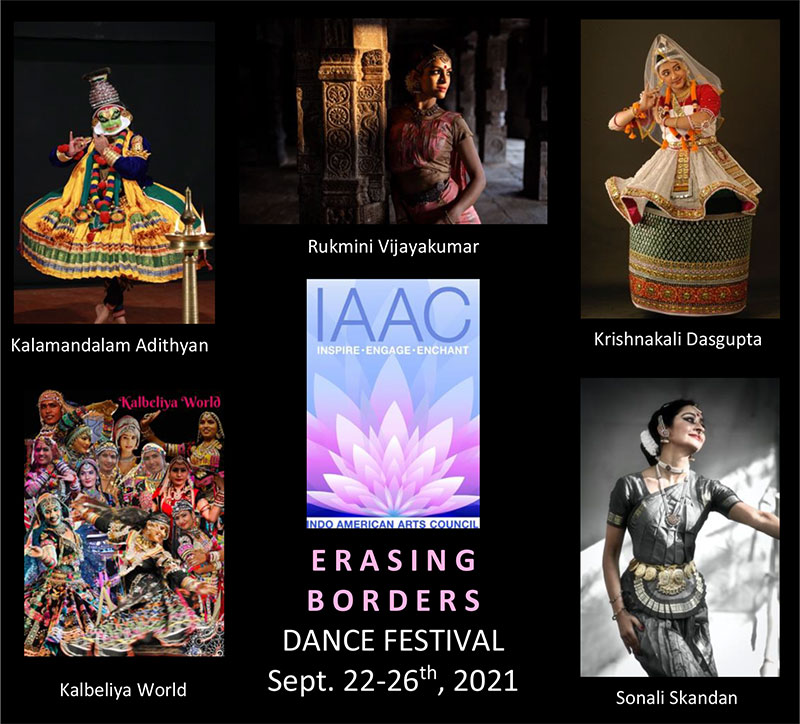
Indo-American Arts Council (IAAC) has announced its annual Erasing Borders Dance Festival, September 22-26, 2021 at 8:30 P.M. ET. Now in its 14th year, the Erasing Borders Dance Festival will be all-virtual in its presentation. Ten artists trained in Indian dance forms from across the world will be brought together in a virtual borderless festival. The dance festival is one among Indo-American Arts Council’s other flagship events featuring music, film, and literature, all dedicated to furthering the knowledge and living practices of the arts of the Indian sub-continent. Register on Eventbrite here to receive Festival updates and livestream links.
Dr. Nirmal Mattoo, Chairman IAAC stated, “This year’s Festival, celebrating the start of the 75th anniversary of India’s independence, will include four performance evenings and two morning workshops. For this year, the curators selected dance works that speak to these reflections on 75 years. Pondering on the issues of old struggles, new ideas, hard won achievements, renewed actions, and future facing resolutions, the Festival curators selected works where artists think of dance as their personal journey. They reflect on how dance stimulates awareness and how dance may direct a sustainable future. The artists proudly present their dance as heritage and as part of the global world.”
Participating artists include Rukmini Vijayakumar, Preethi Athreya, Sonali Skandan, Kalamandalam Adithyan, Kaustavi Sarkar, Jyotsna Vaidee, Vaishali Trivedi, Bindu Rajendren, and Meera Sreenarayanan. Performances highlight Bharatanatyam, contemporary, Rajasthani folk, Kathakali, Odissi, and Mohiniyattam forms of dance. New to the festival this year will be a documentary presentation on September 23 by Kalbeliya World, an international solidary program that safeguards the art forms of women from traditional families of the Kalbeliya community in Rajasthan. Two morning workshops will round out the festival on September 25 and 26 at 10:00 A.M. ET. The first is led by Dr. Krishnakali Dasgupta and covers the Indian classical dance style of Manipuri and the second is a Rajasthani folk workshop conducted by Aakansha Maheshwari.
"The Erasing Borders Dance Festival was first imagined 14 years back for local New York audiences,” said Deepsikha Chatterjee, Erasing Borders Dance Director for IAAC. “It has always been and will continue to be a transcontinental festival given the focus on Indian dance, whose practitioners live all over the world. Offering the festival virtually allows Indian dance to be seen across the world and in many of its original settings. In 2020 we were able to feature a Purulia Chhau dance company of 12 artists of Ashpara Care Club performing in their village square. Krishnakshi Kashyap performed Sattriya, a 400-year-old living dance form in the temple complex, in front of the deities as originally meant to be performed as a devotional practice. This year, similarly, we will feature Kalbeliya World, a documentary on 12 female Kalbeliya folk dancers and their drumming accompanists distributed in three different locations in Rajasthan. And Kalamandalam Adithyan will perform Kathakali assisted by his chuttikar (makeup artist), fellow dancers, and several musical accompanists, capturing Kathakali's natural flavor from the southwestern state of Kerala. Virtuality has allowed the festival many possibilities.”
"The Erasing Borders Dance Festival is a five-day dance festival that commemorates and promotes the cultural vibrancy and amalgamation of people who call NYC home,” said Suman Gollamudi, Executive Director of the Indo-American Arts Council. “Immigrant artists have always been essential to the creative landscape of New York City. Across multiple disciplines, immigrants are key to the city’s global reputation for artistic excellence. The lineup includes artists who are local New York City residents and are from the Indian-American community.”
Each evening will include a panel discussion with the performers led by moderators who are among the doyen of the Indian dance community, explained Senior Curator Uttara Coorlawala. Kumudini Lakhia, Arshiya Sethi, Sonal Mansingh, and UK's Chitra Sundaram will lead these vibrant panels.
A full schedule of the 2021 Erasing Borders Dance Festival follows:
Wednesday, September 22, 2021, 8:30 P.M. ET, performance moderated by Kumudini Lakhia
Rukmini Vijayakumar Bharatanatyam
Preethi Athreya Contemporary
Sonali Skandan Bharatanatyam
Thursday, September 23, 2021, 8:30 P.M. ET, performance moderated by Chitra Sundaram
Kalbeliya World Rajasthani folk
Kalamandalam Adithyan Kathakali
Friday, September 24, 2021, 8:30 P.M. ET, performance moderated by Sonal Mansingh
Kaustavi Sarkar Odissi
Jyotsna Vaidee Bharatanatyam group
Saturday, September 25, 2021, 8:30 P.M. ET, performance moderated by Arshiya Sethi
Vaishali Trivedi Kathak group
Bindu Rajendren Mohiniyattam
Meera Sreenarayanan Bharatanatyam
Saturday, September 25, 2021, 10:00 A.M. ET
Morning workshop:
Dr. Krishnakali Dasgupta Manipuri
Sunday, September 26, 2021, 10:00 A.M. ET
Morning workshop:
Aakansha Maheshwari Rajasthani folk workshop
About the Performances
Expectations and Yahi Madhava, performed by Rukmini Vijayakumar
Vijayakumar’s Yahi Madhava is an Ashtapadi, (love poems of Radha and Krishna), from the Gitagovinda of Jayadeva. Radha and Krishna represent the Purusha, and Paramatma, and the idea that one cannot possess the universal truth as it belongs to everyone. One can only recognize its presence in everything by surrendering to it.
Contemporary new work by Preethi Athreya and film-maker Vijay Boothalingam
These innovative artists come together for an exploration of the salt pans at Marakkanam, Tamil Nadu, to reflect upon the materiality of the site and its imprint on the body. The first of a three-part series, this particular project is a response to the terrain in the fallow period when salt production is suspended due to unseasonal rain and as such, it navigates a submerged terrain over salt deposits within clayey soil. The body is placed at the meeting of earth, water, and salt to challenge its own power and stability and to perhaps think of what we may consider to be eternal or transient.
The Adventures of the Naughty Bee, performed by Sonali Skandan
She is a bit mischievous, a bit daring, and full of curiosity and humor…we follow the Naughty Bee as she explores the world around her and never resists a challenge along her journey. The Adventures of the Naughty Bee is a unique work with concept and choreography by Maya Kulkarni, music arrangement by Sonali Skandan, and costuming by Skandan and Kulkarni.
Kalbeliya World, Rajasthani folk-new documentary Kalbeliya, a folk dance performed in the Rajasthan state of India, is one of the most sensuous dance forms. Kalbeliya World is an international solidarity program that safeguards the art forms of women from traditional families of the Kalbeliya community in Rajasthan. Kalbeliya World seeks to provide (1) Digital Literacy (2) Self Employment (3) Stable incomes for female dancers in the regions of Jaipur, Pushkar, and Jodhpur. During this digital performance, we will take you along a journey to the homes of those women, who are the bearers of their arts looking for sustainable alternatives to the future. This performance consists of 12 female artists from Rajasthan. For more information on Kalbeliya World, please visit their website https://kalbeliyaworld.com.
Rukmangadacharitham, performed by Kalamandalam Adithyan
Composed from the great Indian epics, the plays of Kathakali, the classical dance-drama of Kerala, are replete with characters having a wide range of expressions. Through stylized and semi-realistic hand-gestures, body movements, and facial expressions, the actors communicate with the audience. Penned by Mandavappally Ittiraricha Menon (late 18th century), Rukmangadacharitham holds aloft the glory of Ekadashi (the 11th day from newmoon or fullmoon – a sacred day) and the power he attains by observing Ekadashi Vratham. One day he comes to the forest for hunting where he comes across an ethereal beauty, Mohini, sent by Lord Brahma (the creator of the universe) to obstruct his Vratham (fasting) by enticing him to be engulfed in terrestrial pleasures. Sringara (amorousness), considered to be the prince among the Rasas, finds multiple manifestations in the scene below.
Scene I: King Rukmangada’s fame touches uncommon heights owing to the spiritual penance he undertakes. The king Rukmangada is seated while Mohini enters with alluring footsteps and movements. Dazzled by the beauty of the damsel the king addresses her as one with sweet and lovely face and as one who walks like a graceful elephant. He asks her, “Oh! sweet-tongued! Why are you staying all alone in this desolate forest? One having the hair resembling the colour of the beetle! As I see you, Lord Cupid has begun to quarrel with me. Leaving you is much more than the agony of death for me. You may therefore stay along with me. I am servant of your lotus-feet.” Listening to these honey-tinted words, Mohini introduces herself as an ethereal lady and expresses her love towards him. She agrees to be the king’s consort provided he shall execute the pledge. The king is lost in thought for a while. Thereafter, he executes the pledge. The king embraces the damsel and they both leave for his palace happily.
Bichitro Anondo: Enigmatic Bliss, performed by Kaustavi Sarkar
This piece explores rhythm, melody and text in the eastern Indian traditional form called Odissi. Abhinaya is the art of controlled gesticulation and facial expressions while Pallavi is the expansion of a melodic framework. With elements of abhinaya, pallavi and rhythmic patterns, this dance juxtaposes verbal and rhythmic communication. The choreography is inspired by Nobel laureate Rabindranath Tagore’s song, Jaya Tobo Bichitro Anondo Hey Kobi Joyo Tomaro Karuna. Here, the poet is praising abstract forces of nature that synchronize creation and destruction in tandem. The choreography weaves the beauty of nature displaying dancing peacocks, flights of birds, meandering streams, and the encompassing fragrance of flowers which coexist alongside the sorrow of a world ridden with infectivity. The poet describes the dichotomy of timir-jyoti, meaning light and dark and milana-bichheda, meaning union and separation. Unable to comprehend the duality of environmental regeneration alongside the pain and sorrow, the dance concludes with the question: “how does one unravel this enigmatic bliss?”
Prithvii Tatvam, performed Bindu Rajendren
Prithvii Tatvam is a call to action in response to climate change. Bindu Rajendren presents this choreographic work through the lens of a performative environmentalist. Selected Sanskrit verses of the Bhoomi Sukhtham from the Atharva Veda, interspersed with self-composed poetry in English, constitute the musical score for the choreography. Using Mohiniyattam alongside a simpler derivative movement style, Bindu captures the essence of the Sukhtham from her personal perspective. Presented as a Tatvam, this artistic work plays to the idea ‘Thou art That’ - a concept that alludes to the awareness of oneness in all.
Svādhīna, performed by Meera Sreenarayanan
Forever; a freedom fighter
"Where the mind is without fear and the head is held high;…………….//
Where the mind is led forward by thee into ever-widening thought and action//
Into that heaven of freedom, my Father let my country awake.”
Tagore, Gitanjali
It has been 74 years since India was declared independent of British colonialism; a result of a long and tiresome struggle for freedom, and the sacrifices of countless freedom fighters. But the question of whether we have awakened ‘into that heaven of freedom’, where we are the leader of our thoughts, actions, and happiness, that Tagore dreamt of, still prevails. On the contrary, we, human beings, have become violent and aggressive with each other and in our relationship with the world around us. Svādhīna is an inner monologue of such a freedom fighter.
In addition to the above performances, there will also be two new group works performed by Jyotsna Vaidee and Vaishali Trivedi.
The Performers
Kalamandalam Adithyan (Kathakali) hails from Kannur district in Kerala, South India. From the childhood days he had strong interests towards Kathakali. Payyannur TM Premnath is his first Guru. After completing his primary education, he joined Kerala Kalamandalam to study Kathakali from the eighth standard. Kerala Kalamandalam deemed university is an art institute, which offers academic studies along with Kathakali studies. With the guidance and discipline of gurus such as Kalamandalam Mukundan, Kalamandalam Harinarayanan, Kalamandalam Venkataraman, Kalamandalam Suryanarayanan, Kalamandalam Ramdas and Kalamandalam Krishnakumar, he completed his studies from 8th standard to degree. The stage entry was completed in 2009 by portraying the role of Krishnan in Purappadu. He continued onto a Masters program at Kerala Kalamandalam. During his masters, he received extensive opportunities to learn the art from renowned gurus such as Padmashree Kalamandalam Gopi (Gopiyasan) and Kalamandalam MPS Namboothiri.
Preethi Athreya (Contemporary) a Chennai-based contemporary dancer, trained in Bharatanatyam and later went on to do a postgraduate degree in Dance Studies (Laban Centre, London, 2001). Keenly conscious of her need to be defined not as the exotic other, she chose to continue her journey in her native Chennai.
Between 1999 and 2011, she worked with Padmini Chettur from where she inherited the evolving legacy of Chandralekha and a strong commitment to constantly redefining the Indian body. Working within the Indian contemporary dance scene as a performer, choreographer, and facilitator, Preethi belongs to a league of dance-makers in India today who use dance as an agent of change. Some of her well-known works are Conditions of Carriage: The Jumping Project (2015), The Lost Wax Project (2018), Light Doesn't Have Arms To Carry Us (2013), and BIRD (2021).
Preethi is one of the co-founders of Basement 21, a practice-based performance collective in Chennai. Her publications include a review of Total Masala Slammer by Belgian choreographer, Michel Laub/ Dance Research Journal, New York, 2014.
Dr. Krishnakali Dasgupta (Manipuri workshop) is a recipient of the prestigious Govt. of India National Scholarship for Outstanding artistes for Manipuri (Senior) and a senior student of the Manipuri exponents Smt. Poushali Chatterjee, Dr. Sohini Ray, Guru Smt. Kalavati Devi and Guru Smt. Darshana Jhaveri, as well as Ojha Ranjeet Chingtham (Thang-Ta). She remains a dedicated performer and explorer of the form for more than 25 years and is a co-director, performer, choreographer with Mitradheya. Krishnakali is a Postdoctoral researcher in the field of Developmental Genetics. Dr. Dasgupta has conducted several Manipuri workshops across countries.
Aakansha Maheshwari (Rajasthani Folk Choreography workshop) was born and raised in Delhi and spent over a decade training in Bharatanatyam under Padmashree Geeta Chandran and toured around India. She also performed with Nectar Dance Company and Shakti Dance Company Productions directed by the renowned Guru Viji Prakash’s and her daughter Mythili Prakash in California.
Aakansha has trained in Indian folkdance styles such as Garba, Kalbeliya, Ghoomar and Bhangra with various Delhi and Rajasthan based teachers who are specialists in their field. She spends two months in India every year - dancing in Rajasthan and serving at Manav Sadhna NGO at Gandhi Ashram, working with hundreds of underprivileged kids. Aakansha acted and danced in the Hollywood movie Vara: A Blessing (2013) directed by Rinpoche Khyentse Norbu, shot in Sri Lanka after which she moved to LA. She is one of the co-founders of Kalbeliya World- an online platform with 12 Kalbeliya teachers and she has been volunteering for over a year in helping the community thrive during Covid crisis through the sustainable teaching model and fundraising.
Her fitness program BollyPop®, which she created in 2015 is becoming popular around Southern California and Utah. Aakansha has trained three instructors- 2 in Salt Lake City and 1 in India. In 2020, the biggest fitness platform in India- Cure Fit had Aakansha's BollyPop® workouts playing on their app. In the last couple years, she has been invited by the Clippers to perform at the game. She had over 60 BollyPop® dancers at the last performance at the Staples Center in LA. Currently, Aakansha has over 80 kids in her weekly classes, and she teaches workouts around LA and on campus at UCLA. She says that her devotion to the art is solely for the purpose of spreading happiness.
Bindu Rajendren (Mohiniattam) is a practitioner of Mohiniattam, based out of Brisbane in Australia. She has performed at international, local, and diasporic festivals and concerts in Australia, United Kingdom, New Zealand, UAE, and India. She has widely collaborated with dancers, theatre artists, spoken word and visual artists, and musicians.
Eloquent facial expressions with graceful and flowing movements that evoke aesthetic experience are characteristics of Bindu’s Mohiniattam performances. As a performing artiste, Bindu's strength is in art of expression and storytelling abilities.
Central to Bindu's dance practices is the elemental spiritual connection through sentiment and devotion. The Covid induced pandemic provided Bindu an opportunity to extend her movement vocabulary to include digital media with great success. As a dance researcher, Bindu has presented papers at various national and international academic dance conferences. An obsession with letting her mind wander is often what inspires Bindu's dance choreographies, artwork, paintings, and poetry.
Dr. Kaustavi Sarkar (Odissi) student of Guru Poushali Mukherjee, Ratikant Mohapatra, and Sujata Mohapatra, is a professor in dance at UNC Charlotte and runs a professional development opportunity for Indian classical dance educators through the continuing education program.
She received the prestigious National Endowment for the Arts grant for bringing Odissi into mainstream arts contexts. A Doordarshan graded, ICCR empaneled, and national scholarship holder, Sarkar has created a substantial body of work in scholarship, performance, and education.
She teaches inside and outside academia and maintains dual careers in performance and teaching. She has taught at Kenyon College and holds a PhD from The Ohio State University (OSU) with interdisciplinary research interests in digital humanities, cultural studies, queer studies, arts entrepreneurship, dance and community, and religious studies. Her monograph Dance Technology Social Justice focuses on Odissi's journey as a technique for social justice. Her second book Shaping S-Curves focuses on female choreographers in the field of Odissi.
Sonali Skandan (Bharatanatyam) is a passionate dancer and choreographer whose work has been described as ‘natural yet tense with the pull of mystery’ (nytheatre.com). Sonali is the Artistic Director of Jiva Performing Arts, where she teaches and creates engaging dance productions, and Jiva Dance, a professional dance company presenting compelling works based on Bharatanatyam. Sonali has received praise in the New York Times, Financial Times, and The NJ Star Ledger, among others. Sonali has been on the dance faculty at Sarah Lawrence College, Queens College, and the Joffrey Ballet Summer Intensive.
Under Sonali’s leadership, Jiva Dance was also the first Indian Classical dance company to be awarded the CUNY Dance Initiative residency and awarded the inaugural Dance/NYC Dance Advancement Fund. Sonali has received support from the NEA, NY State Council on the Arts, and The NYC Dept. of Cultural Affairs. Sonali is featured in Juilliard’s online course for Bharatanatyam. She is a longtime student of the legendary C.V. Chandrasekhar and Bragha Bessell and is receiving creative mentorship with celebrated dancer and choreographer Maya Kulkarni with whom she is exploring and creating rare poetic works.
Meera Sreenarayanan (Bharatanatyam) has been described as a 'sensitive dancer', praised for her subtle expressions and technical excellence which all together completes a narthaki. Meera was under the tutelage of Sri. Prakash, Sri. R.L.V. Anand and Acharya Kalakshetra Nirmala Nagaraj. Now Meera is exploring the art and abhinaya under the able mentorship of Acharya Indira Kadambi.
Many performances and awards are there to her credit. She is a graded artist in Doordarshan and a recipient of CCRT Young Talent and NCERT Creative Talent scholarships. She was chosen as the best junior dancer at The Music Academy Madras Dance Festival 2019. 'Harini', a well-received and appreciated thematic Bharatanatyam solo creation, conceptualized and choreographed by Meera for Natyarangam of Narada Gana Sabha, Chennai, proves her caliber as a choreographer as well.
Vaishali Trivedi (Kathak group) is a Kathak dancer, choreographer and singer based in Ahmedabad. For the past 32 years she has performed in many important festivals and theatres, across India and more than 50 countries around the world. Acclaimed as rare dancer with melodious voice by artists and connoisseurs, Vaishali combines a perfect technique with flowing grace and a very fine sensitivity.
She also had the privilege of performing in the productions of some of the greatest Indian classical artists of our time: her Guru Smt. Kumudini Lakhia, Pt. Ravi Shankar, Pt. Birju Maharaj. She has collaborated with famous choreographers from France, Italy, Brazil, Germany, USA, Switzerland, and Pakistan. Such experiences make her artistic journey a truly unique one.
In 2015 she was awarded the Fulbright Fellowship and was given the Gujarat Sangeet Natak Akademi Award by the Govt. of Gujarat in 2011. Today, Vaishali shares her time between touring, expanding her choreographic work in Kathak style, collaborating with various artists, singing, and teaching at her institute, Sangati Centre for Performing Arts, Ahmedabad.
Jyotsna Vaidee (Bharatanatyam group) is an award-winning Bharatanatyam choreographer and dancer and the founder of Samudra Dance Creations. Samudra has presented at several prestigious festivals including San Francisco International Arts Festival, the PushDance Fest, and the Ragamala Music Society of Canada.
Jyotsna advocates that the authentic technique of Bharatanatyam is a rich language that can be used to communicate and discover themes that are both traditional and contemporary. To that end, Jyotsna has created a number of full length original choreographic productions including The Quest Unsaid, The Caged Birds Sings and Kaavyam, and most recently, The Earth Speaks, which was nominated for an Isadora Duncan Dance Award in 2020.
In addition to her choreographic work, Jyotsna is a well-established Bharatanatyam soloist who has immersed herself in the art for over 25 years. Her performances have received critical acclaim in India and North America. She is a regular performer at India's (Chennai) December dance and music season.
Rukmini Vijayakumar (Bharatanatyam) is the Director of her Classical Dance Company Raadha Kalpa and her art space LshVa, in Bangalore, India. Rukmini began her formal training in dance at the age of eight. She had an initial exposure to ballet, but her primary training and rigorous practice through her early years was in Bharatanatyam.
She began under Guru Padmini Rao, and continued her practice under Guru Narmada, and Guru Sundari Santhanam (a senior disciple of Dr. Padma Subrahmanyam). She was introduced to the teachings of the Natyashastra and pursued an intense training in the Karanas under Guru Sundari Santhanam for many years.
She later was accepted into the Boston Conservatory, and graduated with a BFA in Modern dance and Ballet. She is an avid yoga practitioner and has studied Human Anatomy and Physiology at Boston University. Rukmini's productions have toured the world and have been appreciated by audiences. Her ensemble work, Nayani and Prabhavati have toured the Middle East and USA, and more recently MALA, Unrequited, Talattu and The Dark Lord are productions within the traditions.
About the Erasing Borders Dance Festival
The Erasing Borders Dance Festival of the Indo-American Arts Council (IAAC) invites dancers, dance companies and choreographers across the world to present works of artistic excellence sharing movement, heritage, and inspiration from India. The festival is curated for the New York City public and can now be viewed globally in its virtual edition.
About the Indo-American Arts Council
The IAAC supports all the artistic disciplines in classical, fusion, folk, and innovative forms influenced by the arts of India. We work cooperatively with colleagues around the United States to broaden our collective audiences and to create a network for shared information, resources, and funding. Our focus is to help artists and arts organizations in North America as well as to facilitate artists from India to exhibit, perform, and produce their work here. The IAAC is a 501(c)(3) tax-exempt organization. All donations are tax-deductible to the fullest extent allowable by law. For more information, please visit www.IAAC.us.
Moderators
Kumudini Lakhia
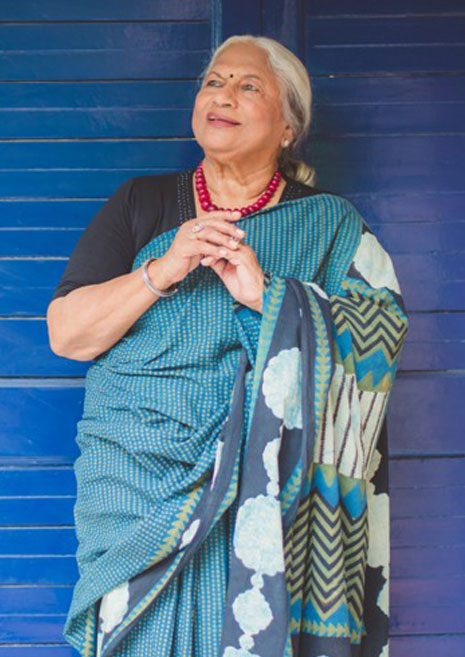
A career in dance spanning over seventy years today Kumudiini Lakhia’s name is synonym with Kathak. After a distinguished profession as a solo dancer, Kumudini Lakhia established the KADAMB Center for Dance in Ahmedabad, India in 1964.
It was at Kadamb that she focused her energies and vision on the development of the technique, vocabulary and repertoire of the Kathak dance. Starting with the small group of students whom she trained in a rigorous routine, she started doing choreography in 1973. Her endeavor was to transform the presentation of Kathak dance with innovative ways for contemporary expression.
Lakhia’s performing company Kadamb has toured extensively around the world where they have received critical acclaim and connoisseur’s appreciation. She continues to lecture on ‘creativity and performance in dance’ at universities in India,USA and countries in Europe.
Having been conferred with the highest civilian award Padma Shree and ‘Padama Bhushan, awardee of the Sangeet Natak Akademi, Guru Acchan Maharaj Award , Sumitra Charat Ram award,’Gaurav Puraskar “from the Govt. of Gujarat, Kalidas Sanman from Govt. of M.P., Tagore Ratna from SNA, and Sharang Dev award by Mahagami Gurukul , Aurangabad, Bhatkhande Puraskar from Lucknow,‘Nagar Bhushan‘from the city of Ahmedabad, ‘ Bharat Muni ‘ award from Nalanda Dance Research Centre, Mumbai and Hanumant Award from Murari Bapu. she has also been honored by numerous cultural institutions for her unique contribution to the world of Indian dance.
Kumudini Lakhia has served on a numerous prestigious organizations of dance namely Vice President the Council International De La Dance, UNA -Paris, Executive Board Member of the Sangeet Natak Akademi, New Delhi, was the Chairperson of the Gujarat State Sangeet Natak Akademi, was the member of the Executive Committee of the Kalakshetra Foundation, Chennai, a Cornel professor at Swarthmore College,Pennsylvania, USA. Kumudini Lakhia is the Artistic Director of the Kadamb Centre for the Dance and Music, Ahmedabad.
Chitra Sundaram
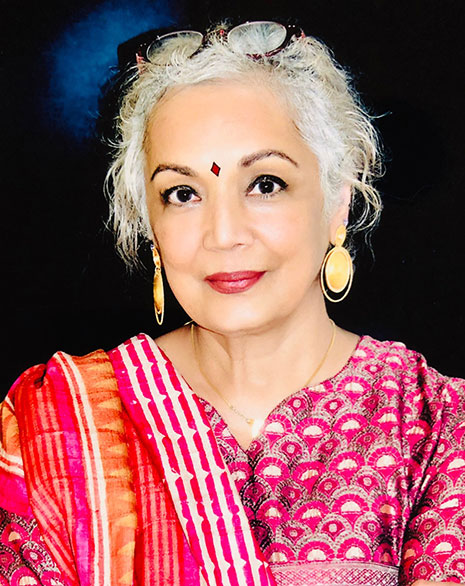
Chitra Sundaram is a dance-theatre practitioner, trainer and researcher whose work reflects her long and multi-rooted experience, sensibilities and questions: ‘Moham - A Magnificent Obsession’ and ‘Skull aka aMhas - The Immortal Sin’ achieved critical and wide acclaim and toured in New York and Toronto. Originally steeped in Bharatanatyam by traditional gurus in India, her expanded disciplines include performance, choreography, dramaturgy, direction, and actor training, working with rising and established choreographers of South Asian Dance especially. Previously, Chitra was the well-known Editor of the internationally subscribed print magazine Pulse - South Asian Dance. Chitra teaches on the MA Performance Making and MA World Theatres programmes at Goldsmiths College, University of London, and is a Fellow of the illustrious dance examination body, the ISTD, and was also elected Fellow of the Royal Society of the Arts. She is India-born, British-based, and a dual British-American national. Chitra has served for many years as Trustee of dance organisations in Britain and was a judge for the BBC Young Dancer Grand Finale in 2019. She was on the ‘Moving Traditions’ panel discussion at Erasing Borders in 2010. On Jan 1, 2021 Chitra was honoured with an MBE, an Order of the British Empire Award, for services to South Asian Dance.
Sonal Mansingh
PadmaVibhushanDr. Sonal Mansingh
Member of Parliament (Rajya Sabha)
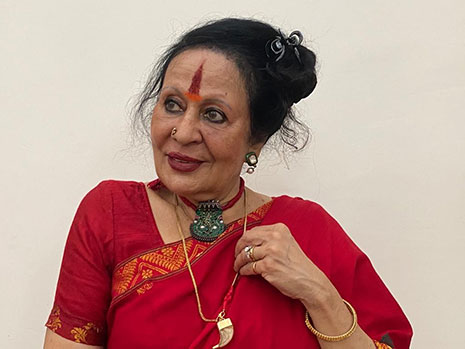
Dr. Sonal Mansingh, was nominated by the President of India to the Rajya Sabha, Upper House of Indian Parliament in July 2018 in recognition of her life-long dedication and service to India’s arts. She is the recipient of Padma Vibhushan in 2003 from Shri APJ Abdul Kalam and Padma Bhushan in 1992 from Shri R. Venkataraman. Prime Minister of India. Shri Narendra Modi nominated her as a NAVRATNA for Swachh Bharat Mission (Clean India Mission).
Her unique contribution has been her lifelong work using her knowledge to address socio-cultural issues through the chosen medium of dance, as an Art Educator, Cultural Activist and Social Motivator.
As the Founder-President of Shri Kamakhya Kalapeeth (Centre for Indian Classical Dances, estd. in 1977 at Delhi) she has trained several thousand talented students who are carrying the message of Indian culture globally. She teaches the Art as holistic concept combining music, yoga, Sanskrit and cultural traditions of India.
Arshiya Sethi

Activist and Independent scholar, Dr. Arshiya Sethi, twice a recipient of the Fulbright Fellowship, writes and speaks on cultural issues. Formerly dance critic for India’s leading daily Times of India, she presented the National programme of Music and Dance on Doordarshan for over three decades, before becoming Advisor, DD Bharati, India’s 24 hours National Arts channel. She was Advisor to Kathak Kendra and has curated three of Kathak Kendra’s festivals including its Golden Jubilee programmes.
In three decades as consultant, building tangible and intangible cultural equities, her defining work was at India Habitat Centre. She helms the Kri Foundation, promoteing ‘Artivism’- Arts and Activism, and writes a featured column about new ideas in dance, for the largest portal of Indian dance- Narthaki. A strong independent voice of artistic leadership, working with several international Universities, think tanks, forums and scholars, she is in the vanguard of efforts to introduce a new US University hosted academic journal on South Asian Dance and its intersections (SADI). Recent efforts to create legal awareness around Arts and the Law has resulted in the website www.Unmute.Help, as a one stop resource center for artistes.
Her academic writings can be found in recent anthologies-“Dance Mattrers Too” (Routledge, 2018), “Indian Dances: Transnational Routes” (OUP, TBP) and “Dance Under the Shadow of the Nation” (2019) a DSA publication which she also co-edited. She is contracted with Routledge for her doctoral work. Forthcoming wirings are on the Indian diaspora and the first decade of Dance in India.
Committee and Curators
Deepsikha Chatterjee: Dance Director
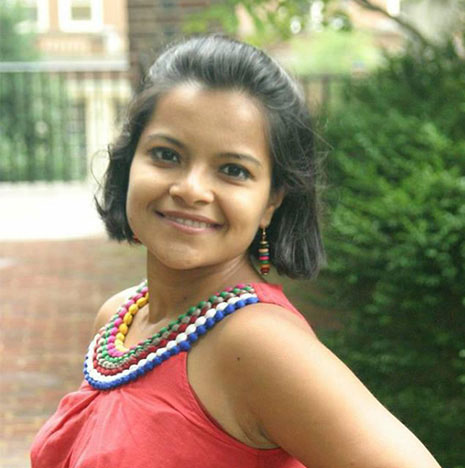
Deepsikha Chatterjee is a tenured faculty of Theatre at Hunter College CUNY where she enjoys teaching a diverse student body. She received her undergraduate degrees from University of Madras and National Institute of Fashion Technology before moving to the US for her MFA in Costume Design from Florida State University.Currently she is pursuing her PhD in Theatre and Performance from CUNY Graduate Center.Her costume design for Butoh Medea and Hide Your Fires received the Best Costume Design award at United Solo in 2014 and 2017 respectively. Her designs have been seen recently at Barnard College, Mabou Mines, Rattlestick Playwrights Theatre, Women’s Project, New York Musical Festival, Drive East, United Solo, Pan Asia Repertory, and Capital Fringe.
She researches costumes and masks for Indian performance and has received notable grants for this work. Her presentations have been seen at conferences including USITT, Costume Society of America, and the Rubin Museum of Art in New York City. She has published articles on Indian and Asian theatre, and Indian fashion. Since 2017 she has served as the dance director for Indo-American Arts Council’s Erasing Borders Dance Festival bringing international dancers to the New York stage.
Uttara Asha Coorlawala: Curator
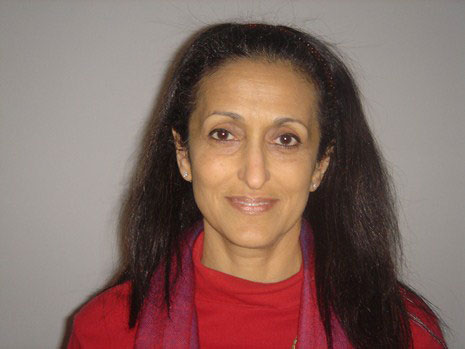
Uttara Asha Coorlawala currently teaches in the dance program at Barnard College/Columbia University and serves as Curator for Erasing Borders--the annual Festival Of Indian Dance. Had previously also taught at Alvin-Ailey- Fordham University Dance Program, Long Island University's C.W. Post Campus, and at Princeton University, NJ. Earlier as a dancer, her solo show, (1973-87) brought modern dance, BharataNatyam and yoga, to stages of India, Europe, East Europe, Japan and the United States. For her pioneering choreography she was recently awarded the Sangeet Natak Akademi national award. (India) Uttara also served on various global dance research (CORD) and educational (IB) Committees, and as Performing Arts advisor to the late Prime Minister Rajiv Gandhi, and at the National Center of Performing Arts, Mumbai.
Awards for writing include AHRB Fellowship for South Asian Dance Research, London, The Graduate Research Award from CORD, USA, the Homi Bhabha Fellowship, India, a Ford Foundation research project (USA) on changing demographies of cultures in the U.S. and an award to study choreography from the Asian Cultural Council.
Currently, she is even more invested in the ongoing global re-flows of body knowledges.
Parul Shah: co-curator
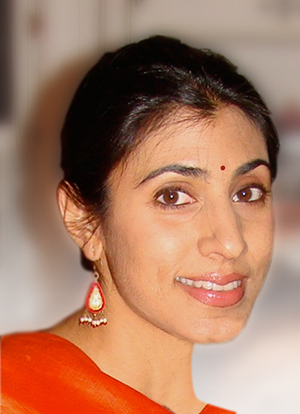
Artistic director, Parul Shah of the Parul Shah Dance Company is an internationally acclaimed Kathak and contemporary dancer and choreographer whose work is expanding the classical medium beyond cultural boundaries. With a dedication to excellence, Shah preserves the form’s aesthetic integrity while exploring contemporary stories and questions around belonging, identity, and empathy. Her work aims to create shared experiences and lasting connections between performers and audiences.
Sruthi Mohan: co-curator
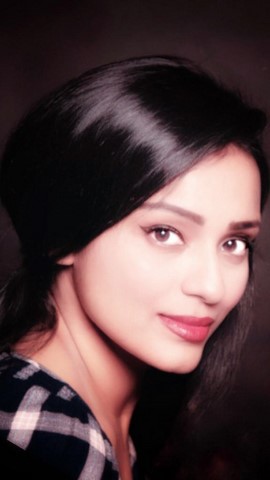
Sruthi Mohan is the Founder and Creative Director of Tat Tvam Asi, a boutique art organization in Austin, Texas, created specifically to curate and present works of internationally acclaimed Indian classical dancers touring the US.
An active and passionate community organizer, with more than a decade of organizational experience, she currently serves as the Cultural Committee Chair of the Austin Hindu Temple and has been instrumental in creating various cultural outreach initiatives that aim to showcase the spiritual beauty of Indian classical dance and other temple arts.
An accomplished and well trained classical dancer who started training at the age of three, she continues to perform to a diverse international audience. She also shares her passion for dance by writing about dance, appearing on radio and TV talk shows to promote and educate a wide and diverse audience about Indian Classical Dance.
Apart from being a dancer and a dance presenter she is also a Co curator for the Erasing Borders Dance Festival, New York.
Dipashreya Sur - Erasing Borders 2020 Festival Intern
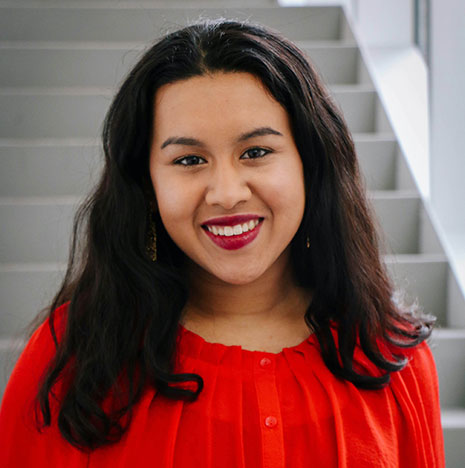
Dipashreya Sur is a rising sophomore at Barnard College of Columbia University majoring in Mathematical Sciences and History and Theory of Architecture. She has been learning Kathak, an Indian Classical Dance form, in the Lucknow Gharana for more than 14 years. On campus she dances with Columbia Taal, an Indian Classical Fusion Dance team. Though Dance originally started off as an extracurricular activity introduced by her parents, overtime it became her passion. Over the years she has also explored dance styles ranging from Contemporary to Afro Cuban. She is honored to be a part of this year’s Erasing Borders Festival.



